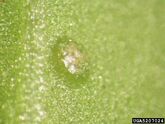| Thrips | |
|---|---|
| Chilli thrips | |
 |
|
| Scientific Classification | |
| Kingdom: | Animalia |
| Phylum: | Arthropoda |
| Class: | Insecta |
| Subclass: | Pterygota |
| Superorder: | Exopterygota |
| Order: | Thysanoptera |
| Family: | Thripidae |
| Subfamily: | Thripinae |
| Genus: | Scirtothrips |
| Species: | Scirtothrips dorsalis |
| Synonyms | |
| Chilli thrips Heliothrips minutissimus Bagnall, 1919 |
|
Chilli thrips (Scirtothrips dorsalis) is an extremely successful invasive species of pest-thrips[1] which has expanded rapidly from Asia over the last twenty years, and is gradually achieving a global distribution.
Symptoms[]
Chilli thrips appear to feed preferentially on new growth, and infested plants usually develop characteristic wrinkled leaves, and a distinctive brown scarring along the veins of leaves, the buds of flowers, and the calyx of fruit.
Treatment[]
Chemical[]
There are a number of insecticides available to manage this pest. It is important to remember that chilli thrips attack developing terminals and buds. The best time to treat a plant is while it is actively growing.[2]
Insecticides for controlling chilli thrips on fruits and vegetables (foliar sprays)[3]:
- Ramon 0.83 EC
- Pylon
- Provado
- SpinTor 2 SC
- Agrimek 0.15 EC
- Baythroid 2
- Neemix 4.5
Pyrethroid insecticides, such as permethrin, cyfluthrin, esfenvalerate and bifenthrin, are not effective against chilli thrips and should not be used, since they are toxic to natural enemies.[2]
Organic[]
Soft products, such as insecticidal soaps, appear to suppress chilli thrips populations. In order for theses products to be effective, they need to be applied on a regular basis. Thrip population have been shown to increase dramatically once applications have stopped.[2]
Biological[]
Predators such as the minute pirate bugs, predatory mites and even predatory thrips have shown potential to control chilli thrips in greenhouse studies.[2]
Prevention[]
To prevent the introduction of chilli thrips into new landscapes it is important make sure that material is not infested prior to planting. New plants being planted could be infesting in a number of ways. The most common method would be to purchase infested plants. However, another overlooked method would be for infested plants removed from the landscape and brought back to a holding area to infest clean plants. When moving plants between properties make sure that they do not have chilli thrips. Infested plants can spread an infestation to holding areas and new landscapes into which they are planted.[2]
Examples[]
References[]
- ↑ Morse, JG; Hoddle, MS (2005). Invasion biology of thrips. Annual Reviews of Entomology 51: 67 – 89.
- ↑ a b c d e Ludwig, S.; Osborne, L.; Ciomperlik, M. (2008). Professional Landscape Management Recommendations for Control of Chilli Thrips. Texas AgriLife Extension Service. p 3.
- ↑ (2005). Chilli Thrips Provisional Management Guidelines. Entomology and Nematology Department, Florida Cooperative Extension Service, Institute of Food and Agricultural Sciences, University of Florida.
| This page uses Creative Commons Licensed content from Wikipedia (view authors). |

